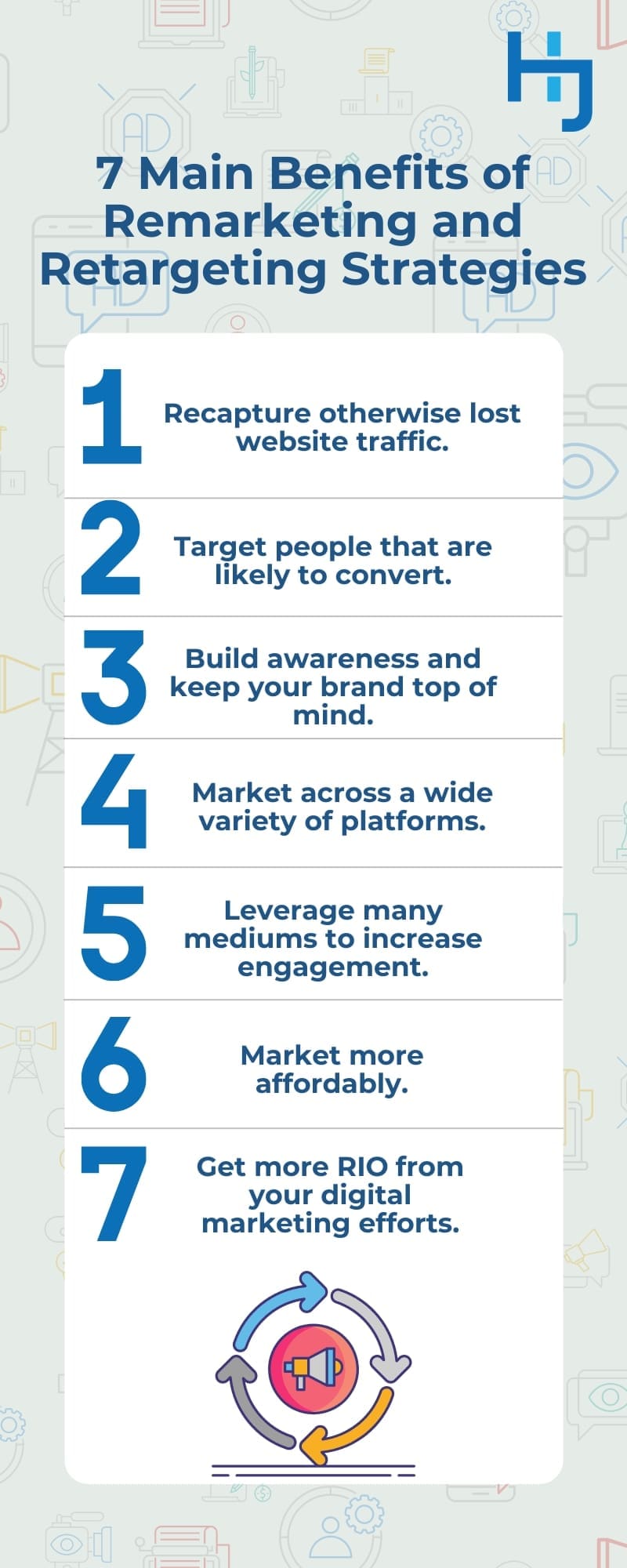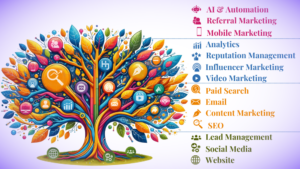 If you’re looking for ways to maximize your digital marketing ROI, remarketing and retargeting should be near the top of your list. Although there are distinctions between the two, they both help you reach people who have engaged with your business before. That means you’ll convert more often and can often catch potential customers you might otherwise lose. Let’s take a quick look at how these marketing tactics work and how you can apply them in your campaigns.
If you’re looking for ways to maximize your digital marketing ROI, remarketing and retargeting should be near the top of your list. Although there are distinctions between the two, they both help you reach people who have engaged with your business before. That means you’ll convert more often and can often catch potential customers you might otherwise lose. Let’s take a quick look at how these marketing tactics work and how you can apply them in your campaigns.
The Difference Between Remarketing and Retargeting
The terms “remarketing” and “retargeting” are often used interchangeably because they work similarly and share common goals. For example, both:
- Can be used to enhance brand awareness and strengthen brand recognition.
- Address a target audience that’s already familiar with your company and/or offerings.
- Build engagement with potential buyers who are likely to convert.
This is how they’re able to bolster your marketing efforts in a big way, but they do it differently.
What is Remarketing?
A remarketing campaign helps reengage your previous customers to encourage them to purchase or do business with you again.
Where is Remarketing Done?
Remarketing is typically achieved through email marketing, but sometimes other means are used.
What is Retargeting?

A retargeting campaign helps reengage prospective customers to help them move further along the buyer’s journey. This includes website visitors and people who have visited your profile on social media platforms or perhaps those who have taken a specific action on one of your digital properties.
With retargeting, you will need some type of web tracking technology to identify the users interacting with your web properties. For example, when a user visits your website, you would collect more data about each user and their interactions. This makes it possible to identify and track the user during this visit and beyond. More often than not, tracking technologies are used for the visitor’s benefit. For example, they can help a website “remember” you’re logged in, so you don’t have to repeatedly enter your password every time you navigate to a new page. Tracking technology can also help a website know which blog post you read on your last visit, so it serves up more content you might like on your next visit. Similarly, one may help you pick up where you left off last time you were shopping online. Web tracking technologies also help webmasters analyze site metrics, and programs like Google Analytics rely on them. It’s how it can provide you with things like user demographics and trends. Marketers and developers use the insights they gain to improve the user experience, too. When it comes to retargeting, web tracking technology allows you to reach your website visitors after they’ve left your site, so you have more touchpoints to build a relationship with them.
Where is Retargeting Done?
Once a web tracking technology is implemented, a person can be reached just about anywhere on the net. A few examples include:
- Display Retargeting: The most common form is display retargeting. This involves being set up with a pay-per-click (PPC) network like Google, Bing, or Yahoo, and then serving your ads to your target audience on sites all over the internet.
- Search Retargeting: Oftentimes, businesses use search ads to boost website traffic before their search engine optimization (SEO) starts generating organic traffic, but it’s a powerful companion to it, too. As the name implies, search retargeting involves showing your ads in search engines right alongside organic search results to people who have visited your website before. Not only can this help you win someone back if they’re now browsing for a competitor, but it can help you nurture those who came to you early in their research and bring them back into your sales funnel, too. If you’re running Google Search Ads, you can do all sorts of segmentation, such as increasing bids for recent visitors or those who have abandoned their carts. Doing so increases clicks and reduces cost-per-click (CPC) quite effectively.
- Native Retargeting: If you’ve been working with content marketing and are leveraging things like blog posts and guides to attract visitors, native retargeting can work for you, too. This involves leveraging a native advertising platform such as Outbrain or Taboola to display ads for your content and redirect previous visitors back to your site. Facebook Audience Network can also work, especially if you’re trying to reach people on mobile devices.
- Social Media Retargeting: An often-underutilized form of social media marketing, retargeting can be done on just about any social media channel, including Facebook, LinkedIn, and Twitter.
Remarketing Strategies & Examples

Again, remarketing focuses on marketing to people who have already done business with you and usually involves email marketing. Let’s take a look at a couple of ways to leverage it.
1. Follow-Up on Abandoned Shopping Carts
Nearly 90 percent of online shopping orders are abandoned, according to Statista. The results vary by industry, with automotive crossing the 96 percent mark and insurance just below 68 percent. While it may seem grim either way, it presents a huge opportunity for savvy digital marketers. Maybe the customer got distracted, the price or shipping was too high, or they simply wanted to hold the item in their cart for later purchase. In any case, you can spur them to action with an offer they can’t refuse. Experiment with what works for your audience, but consider options like free shipping, a discount, or a gift for those who complete the purchase within 24 hours.
2. Reactivate Dormant Accounts
Somewhere between 20 and 30 percent of your email list will decay each year per Stirista. While it may be more challenging in the B2C sector, it’s still a major problem in B2B marketing, too. People change jobs. Your engaged audience will lose interest or move on to other things—especially if your product or service isn’t one they’ll often need. For the sake of maintaining your sender reputation and avoiding spam filters, you can’t keep sending to accounts that aren’t even opening your messages, but you also don’t want to remove email addresses unless they’re bouncing without trying to salvage them.
This is where reactivation campaigns come in. You’ve probably seen some “We Miss You” and “Is This Goodbye?” emails in your inboxes. These tactics can work, but they need to be tailored more to be effective. They should remind the reader of specific benefits they receive from your business and give them a compelling reason to click.
Retargeting Strategies & Examples
Earlier, we covered several types of retargeting or ways to reach people who visited one of your web properties but didn’t convert. Here’s a look at the actual application with a couple of examples.
1. URL-Specific Ads
Retargeting is one of the most effective marketing strategies, but people often set up generic Google ads. For example, a finance company, such as a factoring company, might tag someone who visited their website via a web tracking technology and then later show them display ads with a business owner outside a retail shop and phrases like “competitive rates” and “easy qualification.” It sounds compelling, but what if that person is the owner of a technology company who visited a URL specific to technology industry personas? He’s not clicking that ad no matter how many times he sees it. It doesn’t reflect his needs. When you tailor your Google ads to the content someone viewed, you’ll convert more often. You can do the same with Facebook ads by creating a website custom audience, too.
2. Lead Ads
Are you getting a lot of engagement on social media but not seeing it trickle through to your website? It happens with some brands simply because people catch things in their feeds but don’t always want to break away from their discussions with friends and family to read something else.
Facebook has a solution for this, too. You can create a custom audience based on Facebook or Instagram users and narrow it down to just those who have already engaged with your Page. Then, you’ll visit the Ads Manager to create a new Lead Generation ad.
You’ll need a good lead magnet for this. A free resource such as a guide or webinar works well. You’ll also need solid promotional content. Video marketing can work here, as can a single static image or slideshow. Ask for essential information, such as name and email address, so you can continue nurturing your leads, but keep it as brief as possible. The more information you request, the more people will abandon your form.
The Scenario of Remarketing & Retargeting Combined
Remarketing and retargeting can also be combined to boost effectiveness even more. For example, let’s say you want to reactivate dormant clients, but they’re not opening your emails. You can continue experimenting with email marketing campaigns and show targeted ads to them elsewhere online. Or, maybe you want to help nudge someone to the checkout. You can send them a cart abandonment email and give them compelling reasons to complete the purchase via display ads.
What Are the Main Benefits?
To recap, remarketing and retargeting can help you:
- Recapture otherwise lost website traffic.
- Target people who are likely to convert.
- Build awareness and keep your brand top of mind.
- Market across a wide variety of platforms.
- Leverage many mediums to increase engagement.
- Market more affordably.
- Get more ROI from your digital marketing efforts.
Level Up Your Digital Marketing Strategy
Not sure where to start with a marketing plan or feel like you’ve hit a wall with what you can accomplish on your own? As a digital marketing consultant with a background in business and experience helping companies of all sizes level up, I welcome the opportunity to explore your organization’s next stage of growth with you, too. Contact me for a complimentary consultation.





































































